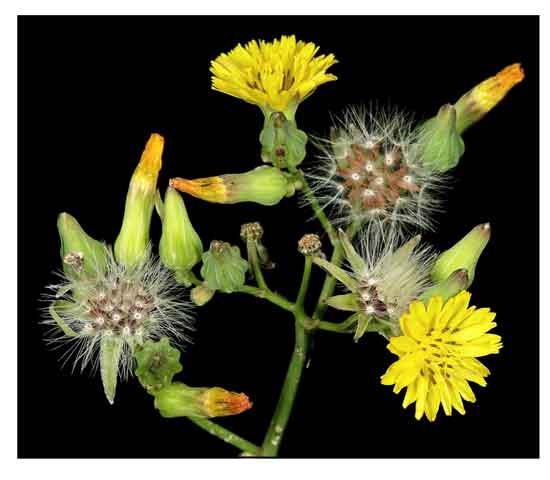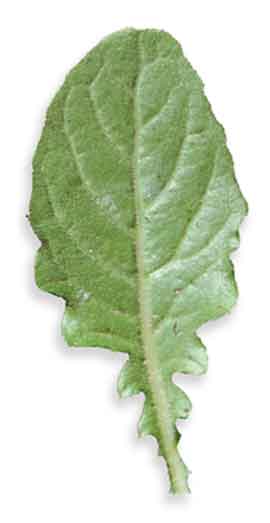 Gen info Gen info
- Youngia is a genus of Asian plants in the tribe Cichorieae within the family Asteraceae.
- Youngia was first described in 1831 by H. Cassini. The genus was later united with Crepis Taxonomic and cytogenetic studies by E. B. Babcock and G. Ledyard Stebbins led to the reclassification
of the genus in the 1930s.
-
Youngia japonica (Oriental false hawksbeard) is a species of flowering plant in the family Asteraceae. It is native to eastern Asia, but is now found as a weed nearly worldwide.
Botany
• Oriental Hawkweed is a biennial herb growing up to 2 ft tall. Basal leaves are in a rosette, lyrate-pinnatifid, lobes toothed, terminal lobe largest. Stem leaves are few, reduced above into bracts. Flower-heads are many, 4-7 mm across, yellow, in corymblike panicles. Involucre bracts are 6-8, narrowly oblong, green, erect. Florets are yellow, 10-20. Seed pods are brown to publish brown, 1.5-2.5 mm long, fusiform, tip narrowed; pappus white, 3-3.5 mm long. (3)
Distribution
- Native to the Philippines.
- A weed in clearings, talus slopes, riverbanks, etc.
- Also native to Afghanistan, Assam, Bangladesh, Cambodia, China, Hainan, Himalaya, Japan, Kazan-retto, Korea, Laos, Malaya, Myanmar, Nansei-shoto, Nepal, Ogasawara-shoto, Pakistan, Sri Lanka, Taiwan, Thailand, Tibet, Vietnam. (1)
 Constituents Constituents
- GC-MS analysis of methanol extract of leaves yielded 10 components, of which 9,12,15 Octadeca-trienoic acid,2,3bis[(trimethylsilyl) oxy]propyl ester, (Z,Z,Z) (RT=58.34%), psi.,.psi. Carotene, 1,1', 2,2'tetrahydro1' hydroxyl1methoxy (RT=23.20%) and hexadecanoic acid, methyl ester (RT=3.64%) were major constituents. (see study below) (4)
- Total phenolic and flavonoid content of ME of leaves at 250 µg/ml yielded 82.62 mg GAE/g and 41.64 mg QE/g, respectively. (4)
- Study of whole plant isolated two new guaiane-type sesquiterpenes (1,2), 2 new phenylpropanoid derivatives (3,4), and 5-oxo-11-hydroxy-8(Z)-undecenoic acid 11-O-glucoside (5) along with 17 known compounds. (see study below) (8)
- GC-MS study of aerial parts for essential oil revealed 31 compounds with menthol (23.53%),
α-asarone (21.54%), 1,8-cineole (5.36%), and caryophyllene (4.45%) as major constituents. (see study below) (9)
- Study of methanol extract of whole plant isolated a new guaiane-type sesquiterpene (1), together with three related guaianolides, youngiajaponicoside A (2), crepiside H (3), and crepeside E (4). (see study below) (12)
- Qualitative phytochemical screening of aqua-methanol extract of Y. japonica
yielded alkaloid +, carbohydrate +++, flavonoids ++, phenols +++, proteins +, quinines ++, saponins +, steroids +, tannins ++, terpenoids ++, with absence of cardiac glycoside. (13)
Properties
- Studies have suggested antiviral, antibacterial, anticancer, antioxidant properties.
 Parts used Parts used
Leaves, stems, roots.
Uses
Edibility
- Leaves are edible, used in salad.
-
Young leaves and stalks consumed as wild vegetable as famine food in ancient time.
Folkloric
- Plant used as febrifuge and antitussive.
- In Bangladesh, paste prepared from leaves and stems are applied to wounds by tying with a piece of cloth. Fresh leaf juice taken three times daily to treat fever. Leaves of plants used for treatment of boils and snakebites. (5)
- In Chinese traditional medicine, leaves are widely used for reducing fever, detoxification, and atopy. Leaf paste applied to relieve shingles. In Bangladesh, leaves applied to wounds, as styptic and to hasten healing. Root juice used as antilithic.
Studies
• Antoxidant / Leaves: Study evaluated the antioxidant activity of methanol leaf extract of Y. japonica. In vitro antioxidant analysis using DPPH, H2O2, and Phosphomolybdenum assay showed significant results compared to ascorbic acid. At 250 µg/ml concentration, ME showed 51.97% inhibition of DPPH, compared to ascorbic acid at 43.54% inhibition; H2O2 scavenging ability of 66.5% inhibition vs ascorbic acid at 61.9% inhibition. The % inhibition of phosphomolybdenum at 250 µg/ml was 93.62 % compared to standard ascorbic acid at 78.62%. (see constituents above) (4)
• Anticancer / Antiviral / Whole Plant: Study evaluated aqueous and ethanol extracts of Youngia japonica for in vitro anti-tumor activity against three cell lines, human promyelocytic leukemia (HL-60), human myelogenous leukemia (chronic K-562) and mouse sarcoma 180 (S-180), and for antiviral activity against respiratory syncitial virus (RSV), influenza A virus (Flu A), and herpes simples virus type 1 (HSV-1) by cytopathic effect (CPE) reduction assay. The hot water extract inhibited cell proliferation and growth of all cancer cell lines to various extents. K-5r62 cells were most sensitive to the extract, and S-180 the least. It showed no cytotoxicity to Vero cells up to concentration of 450 µg/ml. The ethanol extract of whole plant exhibited antiviral activity against RSV cultured in HEp-2 cells, but had no activity against Flu A and HSV-1. (6)
• Anticancer / Antiviral / Whole Plant: Study evaluated antimicrobial agents purified and chemically characterized from ethanol extract of Youngia japonica viz., 3,4-dicaffeoylquinnic acid (1), 3,5-dicaffeoylquinic acid (2), and luteolin-7-O-glucoside (3). The two dicaffeoylquinic acids exhibited prominent anti-RSV with 50% inhibitory concentration (IC50) of 0.5 µg/ml in vitro. Luteolin-7-O-glucoside together with 1 and 2 also manifested some antibacterial activity towards causal agents of food-borne disease, namely Vibrio cholerae and Vibrio parahemolyticus at concentration of 2 mg/ml. Bacillus cereus was sensitive to 1 and 2. (7)
• Anti-Atopy / Antiallergenic / Antioxidant / Whole Plant: Study of whole plant isolated two new guaiane-type sesquiterpenes (1,2), 2 new phenylpropanoid derivatives (3,4), and 5-oxo-11-hydroxy-8(Z)-undecenoic acid 11-O-glucoside (5) along with 17 known compounds. Compound 17, guaiane-type sesquiterpene, grosheimin, exhibited strong antiallergic and antioxidant activities. (8)
• Larvicidal against Aedes albopictus / Essential Oil of Aerial Parts: Study evaluated the larvicidal activity of essential oil of Youngia japonica aerial parts against larvae of Aedes albopictus. GC-MS revealed 31 compounds with menthol and α-asarone as major compounds. The essential oil exhibited larvidical activity against fourth instar larvae of A. albopictus with LC50 of 32.45 µg/mL. α-Asarone and menthol showed larvicidal activity against fourth instar larvae of A. albopictus with LC50s of 24.56 and 77.97 µg/ml, respectively. Results suggest a potential source of natural larvicides. (see constituents above) (9)
• CNS Depressant / Analgesic / Antioxidant / Anti-Inflammatory: Study evaluated the antioxidant potential, analgesic, anti-inflammatory, and CNS depressant activities of different fractions of Youngia japonica plant extracts. In DPPH assay, the chloroform extract exhibited highest scavenging activity with IC50 of 9.70 µg/ml. In hydroxyl radical scavenging assay, the ethyl acetate extract showed most significant activity with IC50 15.09 µg/ml, with highest amount of total phenolic content (43.92 mg GAE/g dried extract). In acetic acid induced writhing, formalin test and Eddy's hot plate method, all fractions significantly (p<0.01) reduced writhing and number of licking in a dose dependent manner. Extracts also showed significant inhibition (p<0.001) of carrageenan induced paw edema. In CNS depressant activity by hole cross test, there was significant (p<0.001) decrease in locomotor activity. (10)
• Phytoremediation / Cadmium Hyperaccumulator: Cadmium (Cd) is one of the most toxic contaminants, causing harm to the environment and human health. Study evaluated Cd(II) effects on growth, biomass, physiological properties, Cd uptake and accumulation in Youngia japonica plants and evaluated the effect of Y. japonica growth on enzyme activity of Cd-contaminated soils. Results showed Y. japonica has typical properties of a Cd hyperaccumulator and may be employed to alleviate Cd from contaminated soils. (11)
• Sesquiterpene Glycosides: Study of methanol extract of whole plant isolated a new guaiane-type sesquiterpene (1), together with three related guaianolides, youngiajaponicoside A (2), crepiside H (3), and crepeside E (4). The isolated compounds 1-4 were evaluated for inhibitory effect on the proliferation of four cultured human tumor cell lines such as A549, SK-OV-3, SK-MEL-2, and HCT-15, in vitro. (12)
Availability
Wild-crafted.
|

![]()



 Gen info
Gen info

